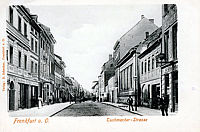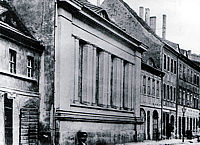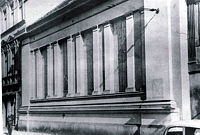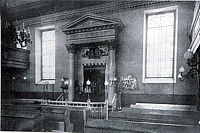G The Reformed Synagogue
 In front of the memorial stone put in the ground for the reformed synagogue, there is a city map on which you can follow the changes in town planning and the altered street patterns. Today's Karl-Marx-Straße leads diagonally across what used to be the parallel streets Tuchmacherstraße and Richtstraße. Both streets were important traffic arteries and enclosed a closely built area in which the synagogue was found - in the map it is marked with a Star of David. Since the first Jewish traders moved into the city they had been dependent on the favour of the Elector. Jews had to pay high duties, and restrictions on their rights as well as expulsions from the town were nothing unusual. In this context, the site of the first synagogue fell into the hands of the Alma Mater Viadrina after a pogrom at the start of the 16th century. The university erected its college building there.
In front of the memorial stone put in the ground for the reformed synagogue, there is a city map on which you can follow the changes in town planning and the altered street patterns. Today's Karl-Marx-Straße leads diagonally across what used to be the parallel streets Tuchmacherstraße and Richtstraße. Both streets were important traffic arteries and enclosed a closely built area in which the synagogue was found - in the map it is marked with a Star of David. Since the first Jewish traders moved into the city they had been dependent on the favour of the Elector. Jews had to pay high duties, and restrictions on their rights as well as expulsions from the town were nothing unusual. In this context, the site of the first synagogue fell into the hands of the Alma Mater Viadrina after a pogrom at the start of the 16th century. The university erected its college building there.
The situation does not substantially change until the 19th century.
 The Jewish inhabitants of Frankfurt have their first opportunity to have them entered in the citizens' register in 1808. The limitations in living and professional rights are also abolished. They immediately become equal citizens of Frankfurt - at least in law - and also get Prussian citizenship.
The Jewish inhabitants of Frankfurt have their first opportunity to have them entered in the citizens' register in 1808. The limitations in living and professional rights are also abolished. They immediately become equal citizens of Frankfurt - at least in law - and also get Prussian citizenship.
The reforms bring the Jewish citizens security and wealth. A liberal climate emerges, in which Jews and non-Jews live and work together. Because of the educational opportunities and the new possibilities for professional development, many Jews move from the countryside to the cities. In Frankfurt, too, the Jewish community grows rapidly at this time.
 In 1822 the community decides to build a new synagogue. To meet the new space requirements, the existing building in Tuchmacherstraße is enlarged and shifts forwards on the footpath by about one metre. The community has the plan approved at state level but neglects to obtain a permit from the city of Frankfurt. A fight over status beaks out, which is finally settled through a generous donation on the part of the Jewish community members - they want to maintain a peaceful atmosphere in the city.
In 1822 the community decides to build a new synagogue. To meet the new space requirements, the existing building in Tuchmacherstraße is enlarged and shifts forwards on the footpath by about one metre. The community has the plan approved at state level but neglects to obtain a permit from the city of Frankfurt. A fight over status beaks out, which is finally settled through a generous donation on the part of the Jewish community members - they want to maintain a peaceful atmosphere in the city.
In September 1823 the new synagogue - a one-storey building in classical style - can be inaugurated. The Holy Ark is embedded into the east side of the simple interior. Two Corinthian pillars and a triangular gable frame it. Four windows face west, into Tuchmacherstraße. The main entrance is through the Jewish culture centre in Richtstraße. Only in 1882 is a second entrance for women created, up to the raised women's gallery. The liberal community has an organ installed, by the Sauer Company. Since then, one has also spoken of the "organ synagogue". The open attitude towards non-Jewish neighbours is shown in the speech of Rabbi Baschwitz at the opening ceremony:
Even if a foreigner who is not of the people of Israel comes and prays in this house, hear him in heaven, your abiding throne, and do all for which he calls upon you, so that no-one should leave this house bowed and disconsolate.
However, not all Jewish inhabitants of Frankfurt are in agreement with the reform of their faith. Jewish immigrants from Eastern European countries, above all, hold fast to their orthodox traditions. In 1840, the community splits. Adherents to orthodox Judaism leave the liberal synagogue and meet from then on to pray in different places - from 1924 at Große Scharrnstraße.
 The liberal climate and peaceful coexistence of all confessions in Frankfurt come to an abrupt end with the start of the Nazi regime. The anti-Jewish propaganda intensifies ever more until, in November 1938, Jewish shops and synagogues throughout Germany are destroyed. The Nazis scrupulously prepare the pogrom. A Frankfurt inhabitant will later remember how the fire brigade pre-emptively wet the houses next to the synagogue on 9th November. A few hours later, the synagogue is burning. For a long time it was assumed that the synagogue was completely destroyed that night. But Eckard Reiß, member of the Historical Society of Frankfurt (Oder), comes through his research to another conclusion:
The liberal climate and peaceful coexistence of all confessions in Frankfurt come to an abrupt end with the start of the Nazi regime. The anti-Jewish propaganda intensifies ever more until, in November 1938, Jewish shops and synagogues throughout Germany are destroyed. The Nazis scrupulously prepare the pogrom. A Frankfurt inhabitant will later remember how the fire brigade pre-emptively wet the houses next to the synagogue on 9th November. A few hours later, the synagogue is burning. For a long time it was assumed that the synagogue was completely destroyed that night. But Eckard Reiß, member of the Historical Society of Frankfurt (Oder), comes through his research to another conclusion:
The memorial stone erected in 1988 for our Frankfurt synagogue actually has a certain definiteness in its main message: destroyed 1938. After the end of the war, various photographs were taken in Frankfurt by the photographer Fricke, who took them as records for comparison with photos from the 1930s. Among other things, there is a view of Wilhelmsplatz, looking into Wollenweberstraße. In this shot one can see that the synagogue is not destroyed.
So the building survives the pillage of 1938 relatively unharmed, even if the interior is destroyed. Its further use until 1945 is further evidence of the building's good condition. Eckhard Reiß:
From the pogrom night until its collapse, it was used as a paper store. And that already allows us to infer: a stock of paper can't normally be stored in a destroyed building; that doesn't make sense.
It cannot be determined today when exactly in the post-war period the synagogue is demolished. On a 1953 aerial photo of Frankfurt documenting the largely demolished old town, it has already disappeared.
Among the guests at the inauguration of the memorial stone in the late 1980s is the last rabbi of the Frankfurt community, Curtis Cassel. With this gesture, Erich Honecker, working towards an official visit to the U.S.A. in the last years of his office, is probably trying to improve his relationship to the World Jewish Congress.
The importance of continuing to face up to the Jewish history of Frankfurt is, not least, shown by the multiple desecrations of the memorial. In 2006, a group of extreme right-wingers destroys the flowers and candles left there after a commemoration ceremony, and chants Nazi slogans.
1. und 3. Abbildungen: Bildarchiv Bernhard Klemm, Frankfurt (Oder)
2. und 4. Abbildung: Bildmaterial aus dem Stadtarchiv Ffo
Lisa Frach, student at the European University Viadrina
|